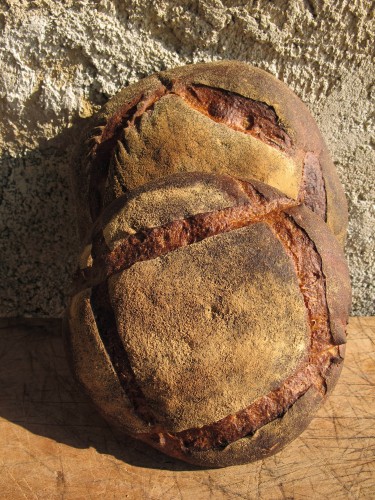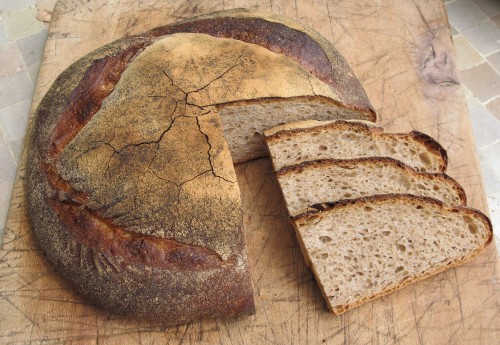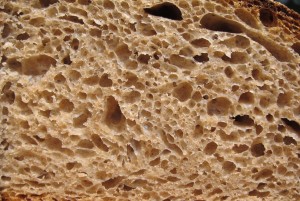Pain Poilâne
One of the most prestigious boulangerie in Paris has been run by the Poilâne family for almost 80 years.The boulangerie was started in 1932 by Pierre Poilâne, creating the world famous Poilâne Miche by mixing: stiff levain, gray stone-ground whole wheat flour, spelt flour, gray sea salt from Guérande, water…. and then baking in a traditional wood fired oven. Pierre Poilâne’s core philosophy for products he sold was they should be made with the simple ingredients and be hand crafted. Pain Poilâne, a traditional whole-wheat peasant loaf, has a distinctive rich taste.It’s crumb is slightly sour and chewy and the crust is dark and earthy colored.It has become one of the most famous sourdough breads in France and throughout the world.
Both the traditional methods and the philosophy for crafting the pain were carried on by Pierre’s two sons, Max and Lionel in 1970.The brothers parted ways after a disagreement, but continued the Poilâne tradition in their separate shops, expanding upon the legacy of doing as much work as possible by hand, and giving the baker the responsibility for making these 2 kilogram loaves from start to finish. The only change to the original formulation was the kneading was done by machine and not by hand. Check out an interesting behind the scene lookat one of the Poilâne boulangeries in Paris.
Although Lionel and his wife were killed in a tragic helicopter accident off the coast of Brittany in 2002, the Poilâne tradition was carried on by his daughter Apollonia who expanded the enterprise. An extensive article about Apollonia’s baking empire (annual sales of more than $18 million, 150 employees) shows how the organization produces up to 10,000 loaves of chewy, thick-crusted brown bread loaves daily for delivery to restaurants and shops across France, and shipped via FedEx to over 20 countries around the world. I actually found Poilâne miche at a bakery that receives shipments from France every three days while visiting some friends in East Hampton, New York. I could not believe it! So, visiting Poilâne is on the top of my to-do list when I make it to Paris in the fall — along with visiting 10 other boulangeries in the city. Local Breads by Daniel Leader devotes a whole chapter to French breads made with a stiff levain as well as lengthy descriptions of Max’s and Lionel’s boulangerie in Paris. His version of the Poilâne miche recipe uses a combination of stone ground whole-wheat flour and all purpose flour to simulate the type 85 flour that is used in France, but oddly leaves out a key ingredient that is used in Poilâne recipe, 30% spelt flour. The next time I go down to Nice to buy flour, I am definitely going to try a remake of this miche with spelt flour.
Pain Poilâne
Adapted from Daniel Leader’s Local Breads
Desired dough temperature 76°
Levain Starter:
- 50 g stiff Levain starter
- 100g stone-ground whole wheat flour
- 75 g water
Ingredients:
- 100 g Type 55 style- or all-purpose flour (I used the T 65 78-82% extraction)
- 400 g stone-ground whole wheat flour (I used the T 150 90-98% extraction)
- 375 g water
- 225 g stiff whole wheat Levain
- 10 g salt
Bread method:
- Take your levain out of the refrigerator, weigh out the appropriate amount of starter and mash the levain with a whisk in a bowl with the water. Add the flour and stir with a spatula until it comes together. Turned out onto the work surface and knead to incorporate the flours. Place the Levain in a covered container and let it sit at room temperature (70 to 76°) for 8-12 hours or until it has doubled in volume and the surface is domed.
- Pour the water into a large mixing bowl or the bowl stand mixer. Combine the flours until all the ingredients are incorporated. Cover and let it rest for 20 minutes, while the flour hydrates and the gluten begins to develop. (I could not fit my Kitchen Aid Pro in my suitcase, so I mix by hand… I autolyse/rest for one hour before adding the Levain, which really helps the gluten development)
- Kneading By hand: Turn the dough out onto your work surface. I flatten the dough into a large rectangle; smear the Levain on top of the dough. With floured or oiled hands knead a few strokes to fully incorporate the starter, flatten out the dough, evenly disperse the salt and continue kneading for 12 to 15 minutes. I use a combination of the French kneading technique and this method if the dough is really wet to start. For the first couple of minutes it will be a sticky mess on your work surface, but do not yield to the temptation of adding more flour. Stop occasionally and use your bench scraper to gather any stray dough off of your work surface. Continue until you have a good gluten development. You should be able to gently stretch a piece of the dough into a thin membrane that you can almost see through without it tearing. By machine: Add the salt and Levain and mix the medium speed until the dough cleans up the bowl and you reach a good gluten development.
- Transfer of the dough to a lightly oiled container. Cover and let it ferment at room temperature for one hour (70 to 75°). (I keep the dough at a consistent temperature 76° throughout.)If you would like to get a good overall picture of the bread making process for the home baker,I highly recommend you check out Mark’s videos at the Back Home Bakery
- Turn the dough out onto your lightly floured work surface, fold the dough and return it to oiled bowl with folds on the bottom and cover. Let the dough ferment for 2 to 3 hours more. You can incorporate another fold after 50 minutes if you’re dough does not seem to have strength.
- You can make on big miche with all the dough. I divided it into two pieces, one approx. 900 g and 500 g and lightly pre-shape into a boule. Lightly flour the dough, cover and let rest for 10-15 minutes to relax the dough.
- Shape each piece of dough into a boule and place seam side up on a floured couche or into floured bannetons. Cover with a plastic bag or plastic wrap and proof at room temperature for one hour. (70 to 75°)
- About one hour before baking, preheat the oven to 500°with baking stone and a tray in the bottom of the oven for steam. I like to add one cup of water baking or one cup of ice cubes to the bottom tray a few minutes before putting the loaves in the oven for to produce a moist environment for the baking of the proofed loaves.
- Gently turn the proofed miche onto parchment paper or your floured peel. Score the miche. Slide the loaves onto the baking stone, turn down the oven to 470° and continue to bake for 20 to 25 minutes. (I turn the oven down to 450° and then after 20 minutes, rotate them to get an even distribution of the heat.)If you are baking one big loaf,bake until the crust is walnut brown. For a good crust you want a bold bake, when you tap the bottom of the loaf you should hear a hollow thud (that is a technical term).
- Let cool on a wire rack before digging in. This bread gets better with age and will stay fresh up to a week.








